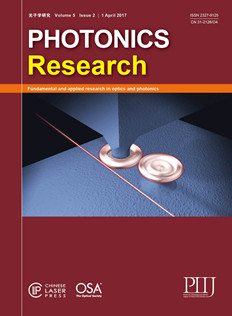
Editor(s): Nicolas Grandjean, Mike Krames
Year: 2017
Status: Published
Light-emitting diode (LED) technology has advanced considerably over the last few decades, yet many device physics mechanisms remain not well understood, and performances at certain wavelengths (especially deep ultraviolet, as well as the green wavelength regime) leave much room for improvement. This special issue of original research articles focus on all aspects of light-emitting diode (LED) technology.
We demonstrate the first commercial production–ready white light-emitting diodes (LEDs) for the general illumination market with red colloidal quantum dots (QDs) applied in an on–chip configuration. We show the red QDs with tunable peak emission and narrow full width at half-maximum in combination with a conventional phosphor material can lead to LED conversion efficiency improvements of 5% to 15% over commercial phosphor based LEDs at correlated color temperatures (CCTs) ranging from 5000 to 2700 K. Furthermore, the challenges associated with reliability under high temperature, high blue flux intensity, and high humidity operation have been overcome to meet consumer market requirements. Finally, a demonstrator lamp at 3000 K color temperature and 90 color rendering index (CRI) with QD based LEDs show a larger efficiency gain up to 17%, attributed to the reduced blue LED droop from the lower drive current and the lower heat sink temperature when compared to a standard phosphor based LED lamp output.
A simple semi-empirical model for radiative and Auger recombination constants is suggested, accounting for hole localization by composition fluctuations in InGaN alloys. Strengthening of fluctuation with the indium molar fraction in InGaN is found to be largely responsible for decreases in both the radiative and Auger recombination constants with emission wavelength. The model provides good fitting of the experimental spectral dependencies of the recombination constants, thus demonstrating implication of the carrier localization to light-emitting diode efficiency reduction in the “green gap.”
Quantum dots are finding increasing commercial success in LED applications. While they have been used for several years in remote off-chip architectures for display applications, it is shown for the first time to our knowledge that quantum dots can withstand the demands of the on-chip architecture and therefore are capable of being used as a direct phosphor replacement in both lighting and display applications. It is well known that, to achieve improved color metrics in lighting as well as increased gamut in display technologies, it is highly desirable to utilize a downconverter with a narrow emission linewidth as well as a precisely tunable peak. This paper will discuss the results of on-chip use of quantum dots in a lighting product, and explore the opportunities and practical limits for improvement of various lighting and display metrics by use of this unique downconverter technology.
Displays using direct light emission from microscale inorganic light-emitting diodes (μILEDs) have the potential to be very bright and also very power efficient. High-throughput technologies that accurately and cost-effectively assemble microscale devices on display substrates with high yield are key enablers for μILED displays. Elastomer stamp transfer printing is such a candidate assembly technology. A variety of μILED displays have been designed and fabricated by transfer printing, including passive-matrix and active-matrix displays on glass and plastic substrates.
We demonstrate InGaN violet light-emitting superluminescent diodes with large spectral width suitable for applications in optical coherence spectroscopy. This was achieved using the concept of nonlinear indium content profile along the superluminescent diode waveguide. A specially designed 3D substrate surface shape leads to a step-like indium content profile, with the indium concentration in the InGaN/GaN quantum wells ranging approximately between 6% and 10%. Thanks to this approach, we were able to increase the width of the spectrum in processed devices from 2.6 nm (reference diode) to 15.5 nm.
Visible light communication (VLC) is a promising solution to the increasing demands for wireless connectivity. Gallium nitride micro-sized light emitting diodes (micro-LEDs) are strong candidates for VLC due to their high bandwidths. Segmented violet micro-LEDs are reported in this work with electrical-to-optical bandwidths up to 655 MHz. An orthogonal frequency division multiplexing-based VLC system with adaptive bit and energy loading is demonstrated, and a data transmission rate of 11.95 Gb/s is achieved with a violet micro-LED, when the nonlinear distortion of the micro-LED is the dominant noise source of the VLC system. A record 7.91 Gb/s data transmission rate is reported below the forward error correction threshold using a single pixel of the segmented array when all the noise sources of the VLC system are present.
This paper reports a comprehensive analysis of the origin of the electroluminescence (EL) peaks and of the thermal droop in UV-B AlGaN-based LEDs. By carrying out spectral measurements at several temperatures and currents, (i) we extract information on the physical origin of the various spectral bands, and (ii) we develop a novel closed-form model based on the Shockley–Read–Hall theory and on the ABC rate equation that is able to reproduce the experimental data on thermal droop caused by non-radiative recombination through deep levels. In the samples under test, the three EL bands are ascribed to the following processes: band-to-band recombination in the quantum wells (main EL peak), a parasitic intra-bandgap radiative transition in the quantum well barriers, and a second defect-related radiative process in the p-AlGaN superlattice.
Spurred on by the invention of the blue light-emitting diode (LED) a quarter of a century ago, the LED industry has advanced dramatically and has revolutionized the signaling/signage, mobile and flat panel display, and more recently, general lighting markets. Indeed, LEDs now out-surpass in performance all conventional (e.g., incandescent, fluorescent, high-intensity discharge) light sources in general illumination applications. The question arises: what more is to be done Thus comes the thesis for this special issue on LEDs and applications. From the contributed articles, we learn that LED technology continues to evolve and transform itself not only within the existing applications but is also positioning for brand new applications to come, both of which are highlighted here.















